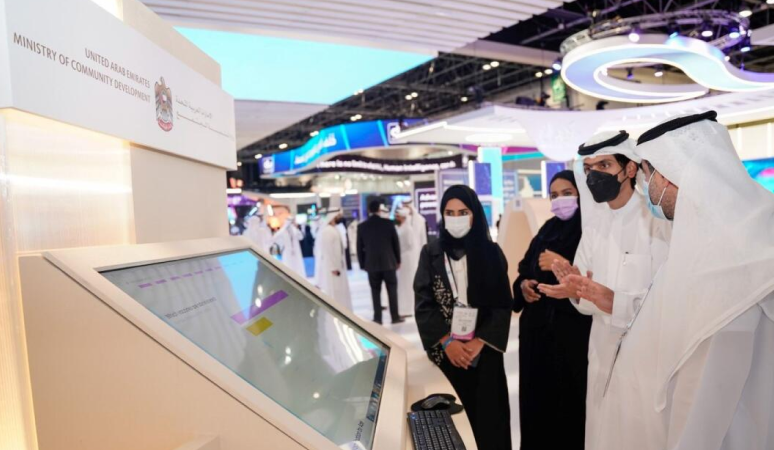Personalized User Experiences in...
Dubai, UAE – July – Personalized user experiences...

As the world becomes more digitally connected, the next leap in technology—5G connectivity—is set to revolutionize consumer technology. The fifth generation of wireless networks promises to deliver faster speeds, lower latency, and greater connectivity, unlocking new possibilities for everything from smart devices and autonomous vehicles to augmented reality and beyond. As we move into 2025, 5G is poised to reshape how we interact with technology, driving innovation and creating entirely new consumer experiences.
5G, which is already being deployed around the world, is not just an incremental upgrade over 4G—it’s a fundamental shift in how we connect to the internet. With speeds up to 100 times faster than 4G, 5G networks will enable data transfer rates that were once unimaginable, allowing for real-time streaming, high-quality video calls, and near-instantaneous downloads of massive files. This increase in speed is a game-changer for industries ranging from entertainment and gaming to healthcare and education.
Beyond speed, 5G’s low latency—the time it takes for data to travel from one point to another—will be crucial for enabling seamless real-time communication. This reduction in lag is expected to enhance the user experience across a wide range of applications, from gaming to telemedicine, by providing ultra-responsive interactions with minimal delays.
Perhaps one of the most exciting features of 5G is its ability to support a massive number of connected devices simultaneously. This means that 5G will fuel the next phase of the Internet of Things (IoT), enabling an even greater number of smart devices, sensors, and objects to be connected to the internet. As more devices become part of our daily lives, from home appliances to wearables, the efficiency and scalability of 5G networks will be essential for making the IoT a truly integrated part of the modern world.
5G is set to take the concept of the smart home to new heights, enabling a more seamless and interconnected living experience. Currently, smart homes rely on Wi-Fi and 4G networks to connect devices, but 5G's enhanced bandwidth and capacity will allow for faster, more reliable communication between devices, creating smarter, more responsive homes.
Imagine a smart home where your refrigerator, thermostat, lights, security cameras, and even appliances communicate with each other in real-time without any lag. With 5G, smart devices will be able to instantly respond to your commands and even anticipate your needs. For example, smart refrigerators could automatically place grocery orders when you’re low on essentials, while your home security system could instantly alert you to potential threats with high-definition video streaming, even in low-light conditions.
Furthermore, the increased connectivity provided by 5G will support more sophisticated AI-driven automation in homes. AI-powered assistants will be able to manage complex tasks like adjusting home energy usage or controlling appliances based on your habits, creating a truly intuitive and energy-efficient living environment.
5G will have a profound impact on the gaming industry, particularly when it comes to cloud gaming and augmented/virtual reality (AR/VR). The low latency and high bandwidth of 5G will allow for high-quality gaming experiences on mobile devices and tablets without the need for expensive gaming consoles or PCs.
Cloud gaming platforms such as Google Stadia, Microsoft xCloud, and NVIDIA GeForce Now will benefit immensely from 5G, as users will be able to stream graphically intense games without lag or buffering. This will democratize gaming, making it accessible to more people around the world by eliminating the need for high-end hardware.
Moreover, AR and VR technologies will reach new levels of immersion with 5G. The increased bandwidth and lower latency will allow for real-time interactions with virtual worlds and seamless integration with the physical environment. This means that augmented reality applications—whether for gaming, education, or shopping—will offer richer, more realistic experiences. For example, 5G could allow virtual try-ons for clothing and accessories in e-commerce platforms, or provide interactive learning environments for students that simulate real-world scenarios.
5G is also set to play a critical role in the development of autonomous vehicles. Self-driving cars rely on real-time communication between the vehicle, its environment, and other vehicles on the road to make split-second decisions and navigate safely. The ultra-low latency and high bandwidth of 5G will be essential for this, allowing for the near-instantaneous transmission of data between vehicles and their surroundings.
This will enable more advanced features in autonomous vehicles, such as vehicle-to-everything (V2X) communication, which allows cars to communicate with traffic signals, pedestrians, and other vehicles, reducing the risk of accidents and improving traffic flow. With 5G, autonomous vehicles will be able to make decisions based on real-time data, such as road conditions, traffic patterns, and even nearby vehicles' movements, leading to a safer and more efficient driving experience.
5G's impact on healthcare will be profound, particularly in the areas of telemedicine and remote patient monitoring. The low latency and high-speed data transfer provided by 5G will enable high-quality video consultations with doctors, even in rural or underserved areas. This will make healthcare more accessible to patients, allowing them to receive expert advice from the comfort of their homes.
Additionally, 5G will enable the real-time transmission of medical data from wearable health devices, such as heart rate monitors, glucose sensors, and fitness trackers, directly to healthcare providers. This will allow for continuous monitoring of patient health, facilitating early intervention and personalized care. Doctors will be able to make more informed decisions based on real-time data, improving patient outcomes and reducing hospital visits.
Beyond consumer applications, 5G will have a significant impact on businesses, enabling the rapid expansion of IoT and the creation of smart cities. With 5G’s ability to support a large number of connected devices, businesses will be able to deploy more efficient supply chains, improve logistics, and offer personalized customer experiences.
Smart cities will benefit from the high-speed connectivity of 5G, enabling innovations like smart traffic management, connected public transportation, and intelligent infrastructure. For example, traffic signals could automatically adjust to traffic flow, reducing congestion and improving safety. Similarly, waste management systems could monitor fill levels in dumpsters and optimize pickup routes to reduce costs and environmental impact.
While the potential of 5G is enormous, its widespread adoption faces several challenges. The infrastructure required for 5G networks, including small cell towers and fiber-optic cables, needs to be expanded globally. Additionally, there are concerns about data security and privacy, as more devices become interconnected. Ensuring that 5G networks are secure and that consumer data is protected will be crucial for maintaining trust in the technology.
Moreover, 5G’s rollout will require significant investment from both private and public sectors, and the benefits may not be immediately felt in all regions, especially in rural or underserved areas.
The future of consumer technology is intertwined with the evolution of 5G connectivity. As this next-generation network continues to be rolled out globally, the possibilities for innovation in gaming, smart homes, autonomous vehicles, healthcare, and beyond are virtually limitless. By enabling faster speeds, lower latency, and greater connectivity, 5G will not only enhance the user experience but also drive economic growth and technological advancement across the globe.
With the integration of 5G into everyday life, consumers can expect smarter, more responsive, and more immersive technologies that will redefine how we live, work, and connect with the world around us. The future of consumer technology is fast approaching, and 5G will be the catalyst for the next wave of digital transformation.

Dubai, UAE – July – Personalized user experiences...

Dubai, UAE – August – In 2024, sustainability...

Dubai, UAE – September – Healthcare technology is...